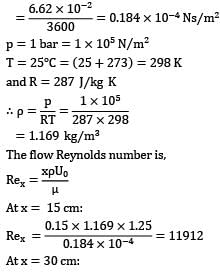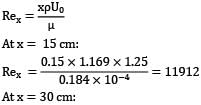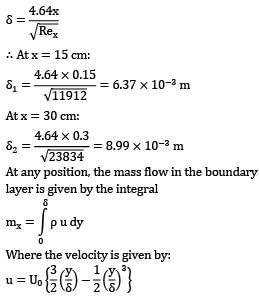Civil Engineering (CE) Exam > Civil Engineering (CE) Questions > Air at 25°C and 1 bar flows over a flat plat...
Start Learning for Free
Air at 25°C and 1 bar flows over a flat plate at a speed of 1.25 m/s. Consider the sections at a distance of 15 cm and 30 cm and from the leading edge of the plate. What would be the mass entrainment (mass flow exiting the boundary layer) between these two sections? Assume parabolic velocity distribution.

The viscosity of air at 25°C is stated to be 6.62 × 10−2 kg ⁄ hr -m. Give your answer in kg/hr.
Correct answer is 'Range: 8 to 9'. Can you explain this answer?
| FREE This question is part of | Download PDF Attempt this Test |
Verified Answer
Air at 25°C and 1 bar flows over a flat plate at a speed of 1.25 m/s....
The density of air is calculated from the characteristic gas equation p = ρRT






View all questions of this test
μ = 6.62 × 10−2 kg ⁄ hr-m

The flow Reynolds number is,

Rex = 0.3 × 1.169 × 1.25 / 0.184 × 10−4
= 23824
For the given parabolic velocity distribution, the boundary layer thickness is prescribed by the relation,

At any position, the mass flow in the boundary layer is given by the integral

Where the velocity is given by;

Evaluating the integral with this velocity distribution,

Thus the mass exiting the boundary layer between the two sections is:

= 2.393 × 10−3 kg ⁄ s
= 8.61 kg ⁄ hr
Most Upvoted Answer
Air at 25°C and 1 bar flows over a flat plate at a speed of 1.25 m/s....
The density of air is calculated from the characteristic gas equation p = ρRT






μ = 6.62 × 10−2 kg ⁄ hr-m

The flow Reynolds number is,

Rex = 0.3 × 1.169 × 1.25 / 0.184 × 10−4
= 23824
For the given parabolic velocity distribution, the boundary layer thickness is prescribed by the relation,

At any position, the mass flow in the boundary layer is given by the integral

Where the velocity is given by;

Evaluating the integral with this velocity distribution,

Thus the mass exiting the boundary layer between the two sections is:

= 2.393 × 10−3 kg ⁄ s
= 8.61 kg ⁄ hr
Free Test
FREE
| Start Free Test |
Community Answer
Air at 25°C and 1 bar flows over a flat plate at a speed of 1.25 m/s....
The density of air is calculated from the characteristic gas equation p = ρRT






μ = 6.62 × 10−2 kg ⁄ hr-m

The flow Reynolds number is,

Rex = 0.3 × 1.169 × 1.25 / 0.184 × 10−4
= 23824
For the given parabolic velocity distribution, the boundary layer thickness is prescribed by the relation,

At any position, the mass flow in the boundary layer is given by the integral

Where the velocity is given by;

Evaluating the integral with this velocity distribution,

Thus the mass exiting the boundary layer between the two sections is:

= 2.393 × 10−3 kg ⁄ s
= 8.61 kg ⁄ hr
Attention Civil Engineering (CE) Students!
To make sure you are not studying endlessly, EduRev has designed Civil Engineering (CE) study material, with Structured Courses, Videos, & Test Series. Plus get personalized analysis, doubt solving and improvement plans to achieve a great score in Civil Engineering (CE).

|
Explore Courses for Civil Engineering (CE) exam
|

|
Similar Civil Engineering (CE) Doubts
Air at 25°C and 1 bar flows over a flat plate at a speed of 1.25 m/s. Consider the sections at a distance of 15 cm and 30 cm and from the leading edge of the plate. What would be the mass entrainment (mass flow exiting the boundary layer) between these two sections? Assume parabolic velocity distribution.The viscosity of air at 25°C is stated to be 6.62 × 10−2 kg ⁄ hr -m. Give your answer in kg/hr.Correct answer is 'Range: 8 to 9'. Can you explain this answer?
Question Description
Air at 25°C and 1 bar flows over a flat plate at a speed of 1.25 m/s. Consider the sections at a distance of 15 cm and 30 cm and from the leading edge of the plate. What would be the mass entrainment (mass flow exiting the boundary layer) between these two sections? Assume parabolic velocity distribution.The viscosity of air at 25°C is stated to be 6.62 × 10−2 kg ⁄ hr -m. Give your answer in kg/hr.Correct answer is 'Range: 8 to 9'. Can you explain this answer? for Civil Engineering (CE) 2024 is part of Civil Engineering (CE) preparation. The Question and answers have been prepared according to the Civil Engineering (CE) exam syllabus. Information about Air at 25°C and 1 bar flows over a flat plate at a speed of 1.25 m/s. Consider the sections at a distance of 15 cm and 30 cm and from the leading edge of the plate. What would be the mass entrainment (mass flow exiting the boundary layer) between these two sections? Assume parabolic velocity distribution.The viscosity of air at 25°C is stated to be 6.62 × 10−2 kg ⁄ hr -m. Give your answer in kg/hr.Correct answer is 'Range: 8 to 9'. Can you explain this answer? covers all topics & solutions for Civil Engineering (CE) 2024 Exam. Find important definitions, questions, meanings, examples, exercises and tests below for Air at 25°C and 1 bar flows over a flat plate at a speed of 1.25 m/s. Consider the sections at a distance of 15 cm and 30 cm and from the leading edge of the plate. What would be the mass entrainment (mass flow exiting the boundary layer) between these two sections? Assume parabolic velocity distribution.The viscosity of air at 25°C is stated to be 6.62 × 10−2 kg ⁄ hr -m. Give your answer in kg/hr.Correct answer is 'Range: 8 to 9'. Can you explain this answer?.
Air at 25°C and 1 bar flows over a flat plate at a speed of 1.25 m/s. Consider the sections at a distance of 15 cm and 30 cm and from the leading edge of the plate. What would be the mass entrainment (mass flow exiting the boundary layer) between these two sections? Assume parabolic velocity distribution.The viscosity of air at 25°C is stated to be 6.62 × 10−2 kg ⁄ hr -m. Give your answer in kg/hr.Correct answer is 'Range: 8 to 9'. Can you explain this answer? for Civil Engineering (CE) 2024 is part of Civil Engineering (CE) preparation. The Question and answers have been prepared according to the Civil Engineering (CE) exam syllabus. Information about Air at 25°C and 1 bar flows over a flat plate at a speed of 1.25 m/s. Consider the sections at a distance of 15 cm and 30 cm and from the leading edge of the plate. What would be the mass entrainment (mass flow exiting the boundary layer) between these two sections? Assume parabolic velocity distribution.The viscosity of air at 25°C is stated to be 6.62 × 10−2 kg ⁄ hr -m. Give your answer in kg/hr.Correct answer is 'Range: 8 to 9'. Can you explain this answer? covers all topics & solutions for Civil Engineering (CE) 2024 Exam. Find important definitions, questions, meanings, examples, exercises and tests below for Air at 25°C and 1 bar flows over a flat plate at a speed of 1.25 m/s. Consider the sections at a distance of 15 cm and 30 cm and from the leading edge of the plate. What would be the mass entrainment (mass flow exiting the boundary layer) between these two sections? Assume parabolic velocity distribution.The viscosity of air at 25°C is stated to be 6.62 × 10−2 kg ⁄ hr -m. Give your answer in kg/hr.Correct answer is 'Range: 8 to 9'. Can you explain this answer?.
Solutions for Air at 25°C and 1 bar flows over a flat plate at a speed of 1.25 m/s. Consider the sections at a distance of 15 cm and 30 cm and from the leading edge of the plate. What would be the mass entrainment (mass flow exiting the boundary layer) between these two sections? Assume parabolic velocity distribution.The viscosity of air at 25°C is stated to be 6.62 × 10−2 kg ⁄ hr -m. Give your answer in kg/hr.Correct answer is 'Range: 8 to 9'. Can you explain this answer? in English & in Hindi are available as part of our courses for Civil Engineering (CE).
Download more important topics, notes, lectures and mock test series for Civil Engineering (CE) Exam by signing up for free.
Here you can find the meaning of Air at 25°C and 1 bar flows over a flat plate at a speed of 1.25 m/s. Consider the sections at a distance of 15 cm and 30 cm and from the leading edge of the plate. What would be the mass entrainment (mass flow exiting the boundary layer) between these two sections? Assume parabolic velocity distribution.The viscosity of air at 25°C is stated to be 6.62 × 10−2 kg ⁄ hr -m. Give your answer in kg/hr.Correct answer is 'Range: 8 to 9'. Can you explain this answer? defined & explained in the simplest way possible. Besides giving the explanation of
Air at 25°C and 1 bar flows over a flat plate at a speed of 1.25 m/s. Consider the sections at a distance of 15 cm and 30 cm and from the leading edge of the plate. What would be the mass entrainment (mass flow exiting the boundary layer) between these two sections? Assume parabolic velocity distribution.The viscosity of air at 25°C is stated to be 6.62 × 10−2 kg ⁄ hr -m. Give your answer in kg/hr.Correct answer is 'Range: 8 to 9'. Can you explain this answer?, a detailed solution for Air at 25°C and 1 bar flows over a flat plate at a speed of 1.25 m/s. Consider the sections at a distance of 15 cm and 30 cm and from the leading edge of the plate. What would be the mass entrainment (mass flow exiting the boundary layer) between these two sections? Assume parabolic velocity distribution.The viscosity of air at 25°C is stated to be 6.62 × 10−2 kg ⁄ hr -m. Give your answer in kg/hr.Correct answer is 'Range: 8 to 9'. Can you explain this answer? has been provided alongside types of Air at 25°C and 1 bar flows over a flat plate at a speed of 1.25 m/s. Consider the sections at a distance of 15 cm and 30 cm and from the leading edge of the plate. What would be the mass entrainment (mass flow exiting the boundary layer) between these two sections? Assume parabolic velocity distribution.The viscosity of air at 25°C is stated to be 6.62 × 10−2 kg ⁄ hr -m. Give your answer in kg/hr.Correct answer is 'Range: 8 to 9'. Can you explain this answer? theory, EduRev gives you an
ample number of questions to practice Air at 25°C and 1 bar flows over a flat plate at a speed of 1.25 m/s. Consider the sections at a distance of 15 cm and 30 cm and from the leading edge of the plate. What would be the mass entrainment (mass flow exiting the boundary layer) between these two sections? Assume parabolic velocity distribution.The viscosity of air at 25°C is stated to be 6.62 × 10−2 kg ⁄ hr -m. Give your answer in kg/hr.Correct answer is 'Range: 8 to 9'. Can you explain this answer? tests, examples and also practice Civil Engineering (CE) tests.

|
Explore Courses for Civil Engineering (CE) exam
|

|
Suggested Free Tests
Signup for Free!
Signup to see your scores go up within 7 days! Learn & Practice with 1000+ FREE Notes, Videos & Tests.
























